Conversational Commerce: How to Use Chat Marketing to Boost Sales (+ Tools)

Good salespeople know securing a sale requires having a conversation—it’s not a one-way street where you simply talk at a lead.
The same principle applies to ecommerce: The industry is shifting, with consumers more connected to each other and the brands they love.
As such, companies need to recognize the active role buyers have in their brand relationships.
Taking part in online conversations with shoppers is vital for building your brand and securing conversions. To meet that end, you’ll need to harness conversational commerce.
Read on to learn more about:
- What conversational commerce is
- Different types of conversational commerce
- Benefits of conversational commerce
- Challenges of conversational commerce
- Conversational commerce tools
- Conversational commerce best practices
- Examples of conversational commerce in action
#cta-visual-pb#<cta-title>Create a website that inspires conversations<cta-title>Use Shogun Page Builder to make it easy for your consumers to get in touch.Start building for free
What is conversational commerce?
First, let’s talk briefly about user-generated content (UGC).
This typically takes the form of reviews or testimonials shared on digital platforms from customers or contributors via photos, videos, or text.
They summarize experiences with a brand, and according to Semrush, 67% of customers make purchase decisions after reading a review or testimonial.
Conversational commerce takes advantage of that added engagement.
Also known as chat commerce, it leverages messaging tools and technology that let you connect with customers at every step of their journey to generate real-time interactions.
Imagine shoppers searching for a solution to their problem. Some of them may spot your brand thanks to timely UGC.
Conversational commerce lets you reach them during this and other stages, including when they’ve made a purchase decision or have become advocates for your brand.
Different types of conversational commerce
Conversational commerce can occur on many channels, and you’ll need a presence on most of them to harness it effectively.
To give you a better understanding, we’ve broken down different types below.
Live chat

“At the very beginning of each chat thread, provide talking points. These are conversation starters in the form of frequently asked questions that visitors can click on to find the answers they’re looking for. They will save time and effort, which could do wonders in terms of engagement and satisfaction.”
— Kris Lippi, real estate broker and ISoldMyHouse CEO
Live chat is a popular communication channel, with 64% of people preferring it over calling a business on the phone.
Most importantly, it lets you actively engage and support your visitors.
For instance, you can guide interested shoppers as they navigate your store, personalizing their experience. Additionally, if a visitor’s problem requires special attention, you can connect them to a live agent.
Chatbots
“It’s essential to incorporate the chatbot into your social media accounts, not just your website. One of the most popular channels for clients to locate businesses is social media, and having a chatbot there to assist them will boost sales.”
— Kris Lippi, real estate broker and ISoldMyHouse CEO
Often used in conjunction with live chat, chatbots are artificial intelligence (AI) powered and act like customer support agents.
They let you instantly connect with customers through automation.
Their key advantage is they allow you to provide people with the information they need across your website, messaging platforms, and along every step of the customer journey simultaneously with minimal effort.
SMS text messaging
Another popular conversational channel you can explore with your audience is SMS.
Texting with friends is quick, easy, and enjoyable. Brands can leverage SMS to take advantage of those positive sentiments and open friendly conversations with shoppers through texts.
With more than 90% of smartphone users keeping their phones within reach at all times of the day, SMS is an excellent way to reach your audience no matter where they are or what they’re doing.
Messaging apps

Apps such as Whatsapp, Line, and Viber, let you instantly exchange direct messages with customers and enable more organic conversations.
Unlike live chat, which usually takes place on a brand’s website, messaging apps are commonly installed on mobile phones, which your shoppers bring around with them.
Through them, you can exchange images, video, GIFs, and other media to produce more engaging interactions.
Another advantage of apps is speed: You can answer questions and receive orders on the spot, as well as iron out specifics and provide real-time updates.
Voice assistants
These voice-activated tools enable searchers to ask their questions and receive answers or be directed to your website instantly.
Their voice commands are as good as Google search queries.
As a result, AI assistants like Siri, Cortana, Alexa, and Google Assistant are now common additions in brands’ marketing and customer support efforts.
For example, to make your content more colloquial, you may structure your articles, how-tos, and help center topics in the form of questions instead of statements.
Someone running a voice search is more likely to ask “Where is your returns center?” versus say “returns center location.”
Social media

Tons of ecommerce occurs via social media: It was estimated that sales through social platforms would hit $992 billion in 2022 and almost $3 trillion in 2026.
This shows how crucial social media is to your strategy.
In addition to making it convenient for shoppers to reach out at any time, these channels work for customer support, upselling, and buyer feedback.
Instagram, Facebook, and Twitter, for instance, have their own direct messaging (DM) features, which provide opportunities for active communication with customers.
TikTok’s comments section even generates lots of engagement from its users.
What’s more, 92% of people look to social media to learn about brands, products, and services, while 68% say their impressions of a brand change after doing so.
Benefits of conversational commerce
The statistics behind conversational commerce clearly indicate these customer conversations can power your bottom line.
Thanks to its authentic approach, deeper customer insights, and potential for higher average order values, conversational commerce comes with a multitude of advantages.
Strengthens your brand authenticity

And, with people valuing more personal experiences as well, being open and willing to speak directly to customers can go a long way toward increasing conversions. Call it conversational marketing, if you like.
In fact, 63% of shoppers expect companies to know about their specific needs and expectations, and that number grows to 76% among B2B customers.
By building personalization into your customer conversations, you can show that you are paying attention to their feedback and desires.
Fuels your marketing team
Superb conversational commerce experiences can also provide you with more marketing material.
For example, you can use snippets from online conversations in your ad copy or highlight UGC that happy customers share on online platforms. (Reminder: Get permission from your customers before quoting or sharing their stories.)
It boosts credibility as well, with consumers being 2.4 times more likely to agree that UGC is more genuine than branded content.
Provides more customer insights
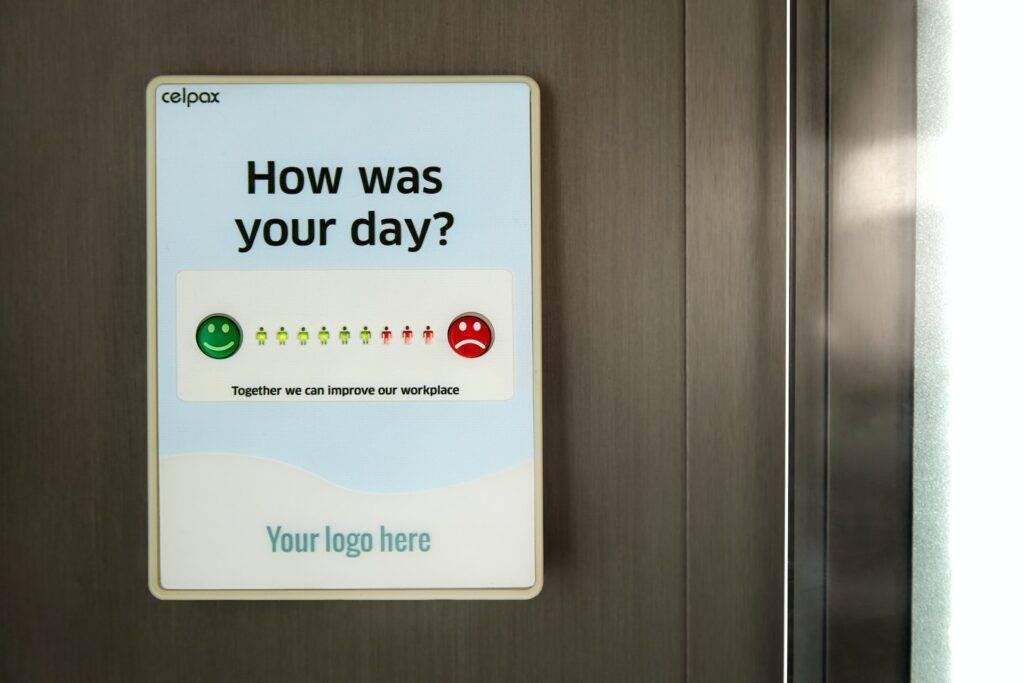
Talking directly to customers is the best way to gain insight into how your products serve them. You can ask them:
- What they like or dislike the most
- Where you can improve
- What you should keep the same
Because the answers from these organic conversations are first-hand accounts, the information is both more reliable and useful.
Boosts conversion rates throughout your funnel
With conversational commerce, you open up lines of communication that allow you to support customers whenever they need it.
This also personalizes their experiences, which improves your conversion rates by roughly 8%—meaning more closed sales and less cart abandonment.
Additionally, pay attention to the common reasons why people drop out of your sales funnel, such as:
- Confusion
- Lack of information
- Tedious purchase processes
- And more
Identifying these issues will help you smooth the way forward for customers by removing more barriers to purchase.
Increases customer lifetime value
Conversational commerce expands your opportunities to nurture customer loyalty and improve retention through organic and real-time conversations.
Forming richer connections and relationships with them will lead to a higher customer lifetime value (CLV), which, in turn, gives you more funds to invest back into your conversational commerce channels.
Yields larger average cart values
An open dialogue with your customers can also lead to more upsells and cross-sells, especially when your team is equipped to spot such opportunities.
In fact, personalized recommendations encourage 80% of consumers to purchase.
Like an exclusive shopper suggesting accessories that pair with an outfit, your brand can make suggestions that customers know are tailored to them.
Businesses that do this well enjoy 40% more revenue on average.
Challenges of conversational commerce
Although it boasts many benefits, the positive results your business gains don’t come free.
Conversational commerce requires an investment of both tangible and intangible resources and introduces new challenges.
Time-consuming
The first challenge conversational commerce poses is its time commitment.
You have to be active on many channels, and, like a true conversation, it should happen in real-time. Keeping interactions as organic as possible requires special attention.
Difficult to implement
Multiple moving pieces are involved as well. You’ll have extra things to juggle and, depending on your volume, you’ll need more staff.
Additionally, audiences can differ depending on the channel, so your approach for each one should be distinct (adding even more unique elements into the mix).
Hard to track
Conversations aren’t data points, so it can be hard to track their success.
You have to be highly organized to extract qualitative information, then convert them into something quantitative to spot trends and patterns.
Additional tools needed
Depending on how many platforms you’re active on and how streamlined you want your customer support inbox to be, you may need extra tools to manage the experience for your audience effectively.
However, many options are available to simplify these tasks, and we’ll tackle some recommendations next.
Conversational commerce tools
Below are a few tools that can help supercharge your conversational commerce efforts.
We’ve included some of the top conversational commerce platforms, conversion tools, and UI builders to generate rich, conversion-yielding conversations.
Heyday
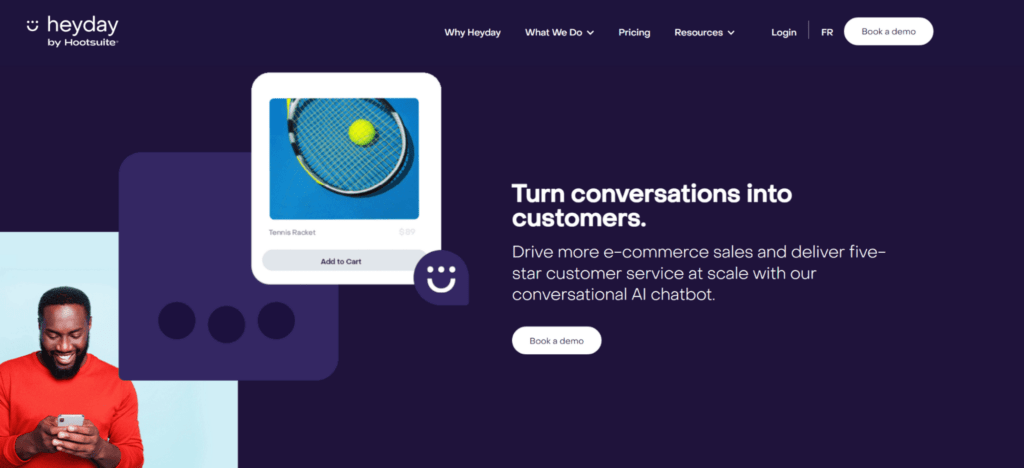
Heyday provides an AI chatbot that serves customers 24/7. It offers support even when agents aren’t live, letting you constantly deliver personalized experiences at scale.
It also has omnichannel chat capabilities, which simplifies your inbox management across all platforms.
Pricing:
- For smaller brands and Shopify merchants: Starts at $49/month; 14-day free trial
- For larger brands: Starts at $1,000/month; free demo
Intercom
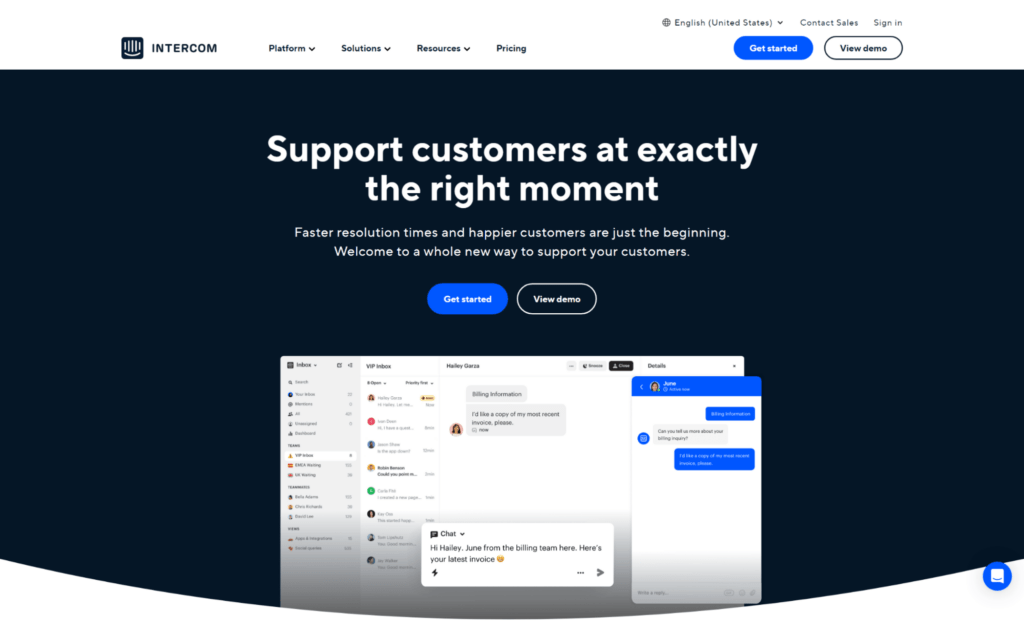
Intercom offers chat, messaging, management, and customer data tools.
It lets you personalize and handle every customer conversation easily, as well as provide constant engagement and support.
Pricing:
- For most businesses: The company’s Support, Engage, and Convert plans are priced based on the number of seats you need and people to reach
- For (very) small businesses: Starter plan starts at $74/month when billed annually
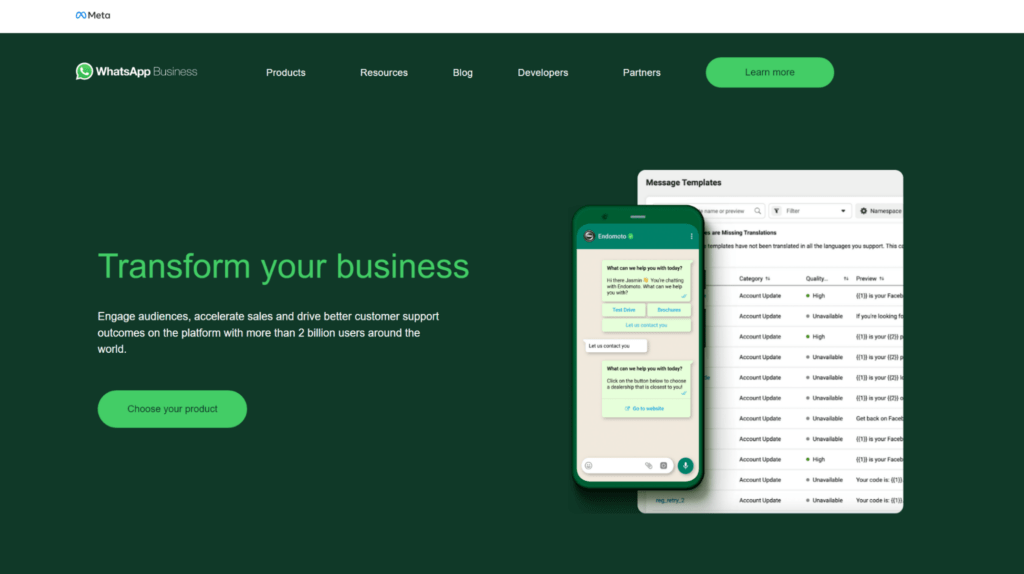
WhatsApp has a Business platform geared towards medium to large businesses, with its API providing certain automations and enabling you to communicate with customers at scale.
You can also directly send updates, promotions, and support.
Meanwhile, its Business app lets small businesses connect with individual customers throughout their journeys.
Both WhatsApp tools can provide personalized experiences, regardless of your business size.
Pricing:
- First 1,000 conversations: Free
- Above 1,000: Varies per region. See WhatsApp’s rate card here.
- Meta Business Partners may charge additional fees
Facebook Messenger

Messenger is a messaging app that lets you reach customers more intimately on Facebook and Instagram.
You can exchange images and videos and add a human touch through emojis and GIFs.
This tool helps you address customer concerns one-on-one and pay attention to their specific needs.
Pricing: Free
Agorapulse

Agorapulse’s social media inbox management tool organizes incoming messages coming from your social platforms in one place.
It lets you identify and label your followers to differentiate them, carry out meaningful conversations, and even manage comments.
Reporting features help you gather quantitative information as well.
Pricing:
- Free: Free
- Standard: $59/month
- Professional: $99/month
- Advanced: $149/month
- Custom: Tailored pricing
Drift

Drift’s Conversation Cloud is a suite of tools that include custom and AI chatbots, conversational landing pages, insights, and more.
You can personalize customer experiences to convert visitors into leads and paying customers.
This tool enables you to engage people at every step of the buyer’s journey and provide the quality support and guidance they need, which can improve your marketing and sales.
Pricing:
- Premium: Starting at $2,500/month, billed annually
- Advanced: Custom
- Enterprise: Custom
#cta-visual-pb#<cta-title>Create a website that inspires conversations<cta-title>Use Shogun Page Builder to make it easy for your consumers to get in touch.Start building for free
Conversational commerce best practices
You should now have a good sense of how conversational commerce works. But before you begin incorporating it into your business, keep the following tips in mind.
Start with research and preparation
“Evaluating demographic segments and data is crucial in conversational commerce. Your strategies should align with messaging services and social media platforms that specific age, gender, and geographic groups frequently use to maintain customer awareness.
These valuable insights allow you to deliver highly personalized messages and conversations that consumers enjoy, boosting the overall customer experience.”
— Allan Stolc, Bankly founder and CEO
Prior to introducing conversational commerce into your marketing strategy, identify any gaps your business may have and the best channels to invest in. Ask:
- Are there any channels you’re unable to serve effectively?
- Which channels do you want to be on but have yet to establish a presence?
- Do you face major issues like shopping cart abandonment?
Remember to research your audiences and appropriate tools to streamline your processes. This helps minimize any hiccups you may encounter during an initiative’s execution.
Invest in 24/7 availability (especially for international markets)
“An AI chatbot operates around the clock like a customer service representative, responding to any simple inquiries clients may have. Even better, they can automatically advertise deals and collect contact information from clients.”
— Kris Lippi, real estate broker and ISoldMyHouse CEO
Ecommerce customers can shop in different time zones, so being available around the clock provides significant convenience.
By providing swift responses to people’s questions and problems, you improve their customer experience and boost the likelihood they’ll make a purchase.
If you have the means, live chat agents are great because they deliver genuinely human interactions.
AI chatbots, meanwhile, are more budget-friendly since they require minimal manpower.
Focus on fast responsiveness
Availability may not be enough, though; you also have to reply to customers promptly.
HubSpot found 90% of shoppers rate an “immediate” response to a customer support issue as important or very important, with 60% of them defining this as 10 minutes or less.
This proves speed is of the essence, and failing to keep up can hurt people’s experiences—and your profit margins.
Personalize your conversational experience
Consider the various stages your customers go through in the buyer journey before making a purchase. What stage are they in when they contact you?
For example, if someone reaches out on your social media channel from an ad, they’re likely only beginning to learn about your brand. However, if they reply to an email after being a long-time subscriber, they’re likely a repeat customer.
Many messaging channels, such as email and SMS platforms, are able to segment subscribers based on their interactions with your brand.
Combined with a CRM, you may even know if they are a current customer (and their purchase history), churned, or lead. You can take all of this information into account when conversing with them and tailor your assumptions accordingly.
Tailor your messaging, information, and offers according to the stage each shopper is in and what they may want to learn more about.
Be empathetic toward customers’ needs
“The best practice for ecommerce conversations is to focus on providing value and creating helpful content for customers. This means answering questions, providing expert advice, and being a resource for your customers. When you do this, you build trust and build a relationship with your customers.”
— Dov Breuer, Fixlers COO
Authentic conversations matter to consumers, and this entails being understanding of their concerns.
Doing so goes a long way toward building trust with your current and potential customers.
A study by Zendesk revealed modern customer service lacks a human touch, and people dislike impersonal and robotic interactions.
In fact, 60% are willing to disengage with a brand after one bad customer service experience.
Tip: If you’re unable to find a solution to a customer’s concern, reassure them and let them know you’re investigating.
Ask for feedback
“… [W]e’ve optimized our response rate on different messaging platforms to ensure that we communicated with the customer within an hour of them reaching out to us.
We also ask for feedback after each interaction on these platforms, which has helped us to significantly improve brand perception over the past two years.”
— Andrew Cussens, owner of FilmFolk
A core component of successful conversational commerce is asking customers how their experiences went.
This can help you identify areas that need improvement and nurture better relationships.
You can conduct follow-ups with minimal resources using chatbots, and since 79% of customers are willing to share relevant information about themselves for improved tailored experiences, you have an easily accessible wealth of information to tap into.
Learn and stay adaptable
“Our team actively monitors customer conversations on reviews and social platforms to gain feedback and engage customers in a meaningful manner. We also use conversational commerce tools to segment audiences, personalize messages and analyze their effectiveness.”
— Skye Westcott, president (US) of Coco Republic
Some challenges in conversational commerce are unavoidable, and it’s impossible to please every customer.
However, being flexible and adaptable allows you to pivot when customer tastes change. Adjust your strategy or execution regularly to accommodate shifting preferences.
6 Excellent conversational commerce examples
To round out this article, here are some exemplary applications of conversational commerce. Let these examples guide your efforts and inspire you to think outside the box.
1. Cocktail Courier
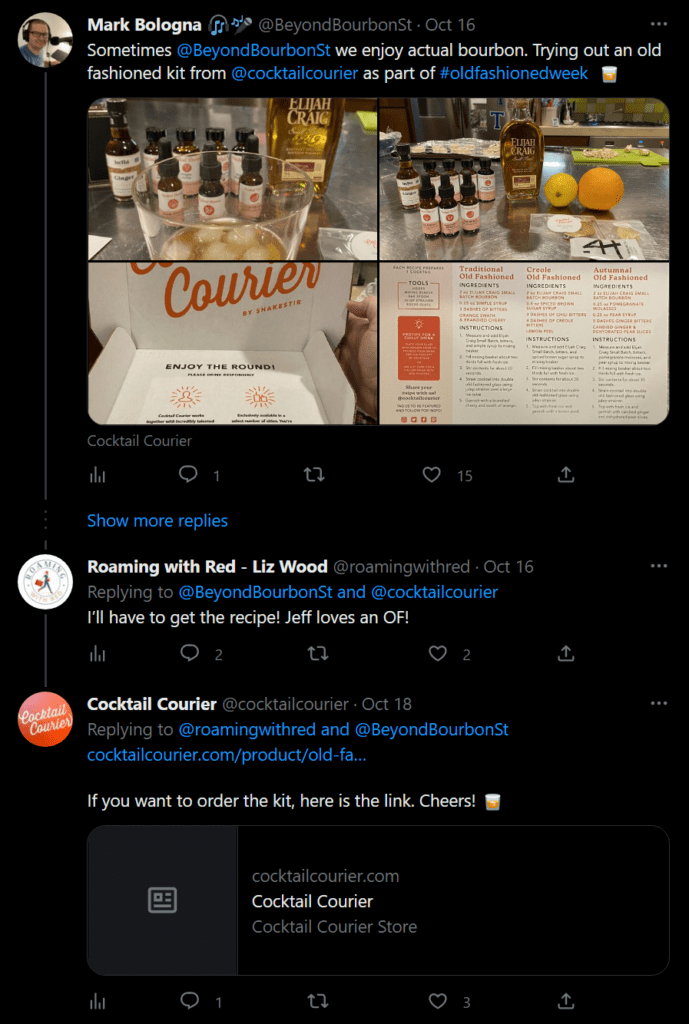
Cocktail Courier provides kits and subscription boxes made from their original recipes.
In the above Twitter exchange, a customer mentioned the brand after receiving his order. His friend then expressed interest in Cocktail Courier’s recipe.
The brand chimed in at the end, and if you view the whole thread, the short conversation flowed naturally. As a result, Cocktail Courier was able to point an interested Twitter user in the right direction—theirs.
2. Briogeo Hair Care
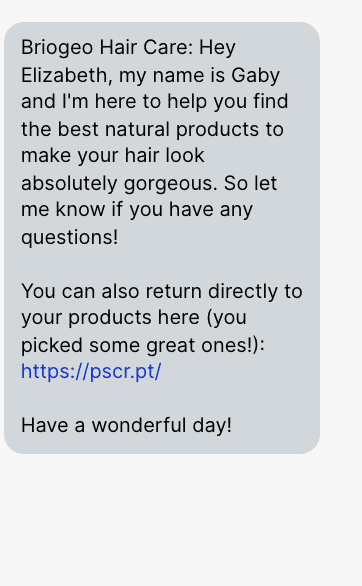
In this text message from Briogeo Hair Care, a friendly and caring expert reached out to help a customer look their best.
Gaby opened up an opportunity for the customer, Elizabeth, to ask questions and shared a link that directed her back to the items she was viewing.
This interaction gave Elizabeth personal access to someone who could address all her concerns.
3. Aquila

Aquila, an Australia-based shoe brand, has demonstrated how a chatbot can answer questions in seconds.
Their bot introduces itself in an approachable manner and encourages customers to offload their concerns.
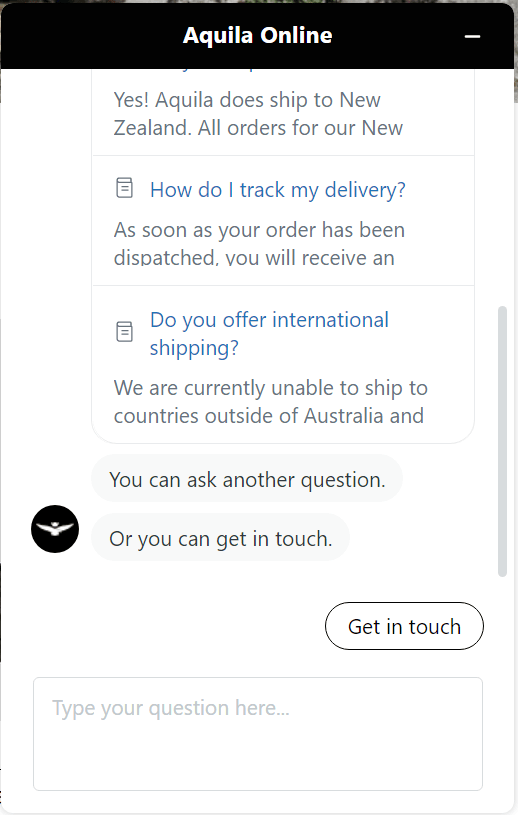
It then shares answers to FAQs that address the shopper’s issue.
If the concern isn’t resolved, it offers customers the opportunity to get in touch directly via email so they can go into specifics and, if needed, share images.
4. Organic Olivia
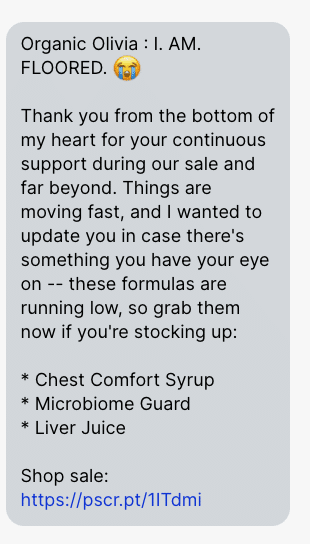
Organic Olivia, an herbal medicine provider, opted to send a personal, heartfelt message of thanks for supporting them during a sale and beyond.
The communication also informed the customer of low-stock sale items, then gave them easy access to their store through a link.
This kind of interaction can make a consumer feel appreciated and that they made an impact on the brand.
5. Leica
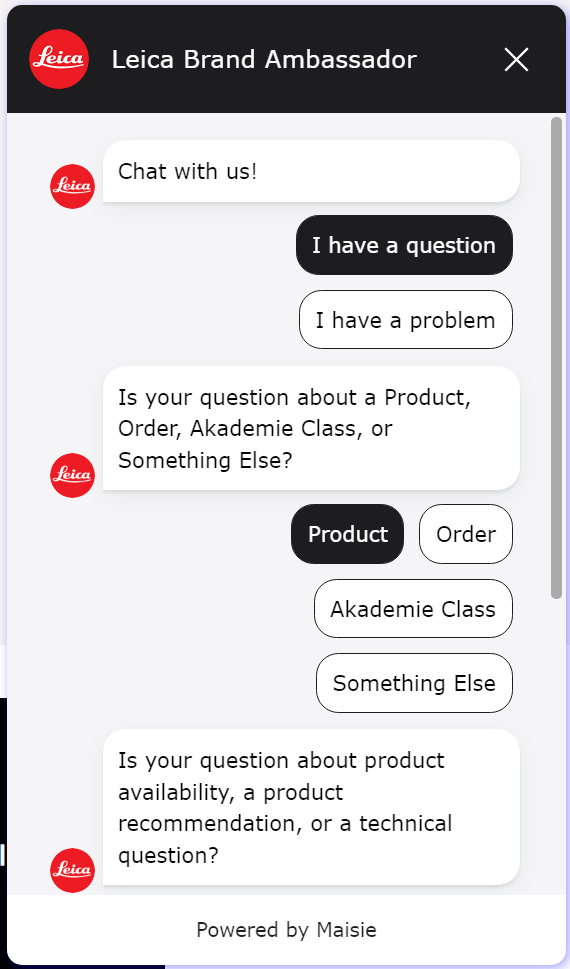
The camera brand Leica’s chatbot follows a straightforward approach in its consumer interactions, providing visitors with options that help narrow down their concerns.
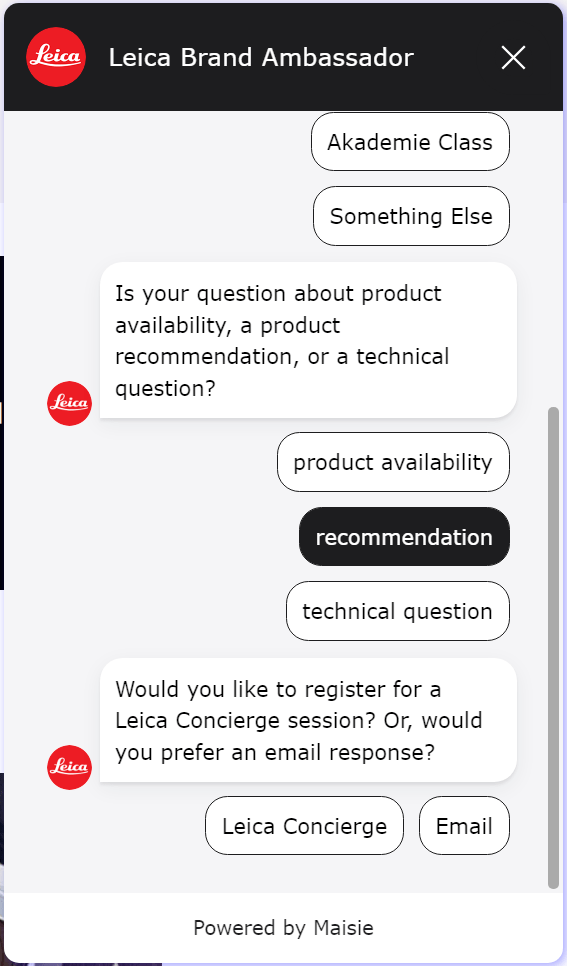
The series ends with a choice either to speak with a Leica Concierge or be contacted via email, indicating the brand will get in touch directly.
The chance for one-on-one communication induces the feeling of receiving personalized service.
6. Chobani
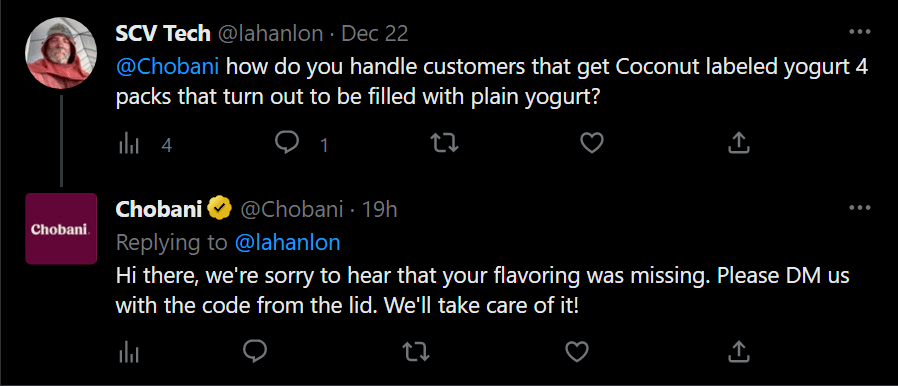
Greek yogurt brand Chobani actively responds to customers on Twitter.
In the above interaction, they personally replied to a customer’s question, then quickly told him the issue would be resolved.
Receiving an apology directly from a brand also adds a human aspect to the exchange, making Chobani seem more approachable and understanding.
Build closer buyer relationships through conversational commerce
Conversational commerce lets you personalize customer experiences and nurture your relationships with them.
It also humanizes your brand and opens up more opportunities to connect with people, resulting in more effective marketing and sales.
Although it requires effort and some resource investment, conversational commerce pays for itself in the long run.
Test the waters with some of the tools and methods we’ve discussed, adjust your strategy, and enjoy the results of creating an approachable brand for your consumer base.
#cta-visual-pb#<cta-title>Create a website that inspires conversations<cta-title>Use Shogun Page Builder to make it easy for your consumers to get in touch.Start building for free

Rachel Go
Rachel is a remote marketing manager with a background in building scalable content engines. She creates content that wins customers for B2B ecommerce companies like MyFBAPrep, Shogun, and more. In the past, she has scaled organic acquisition efforts for companies like Deliverr and Skubana.



